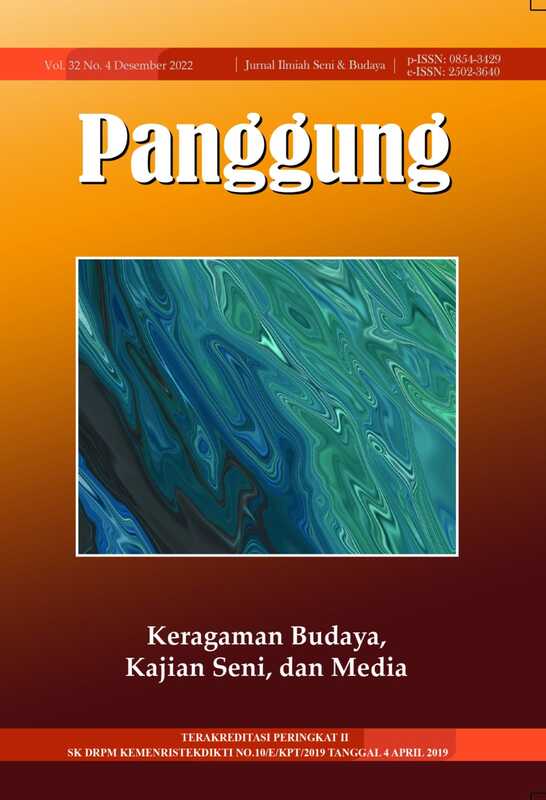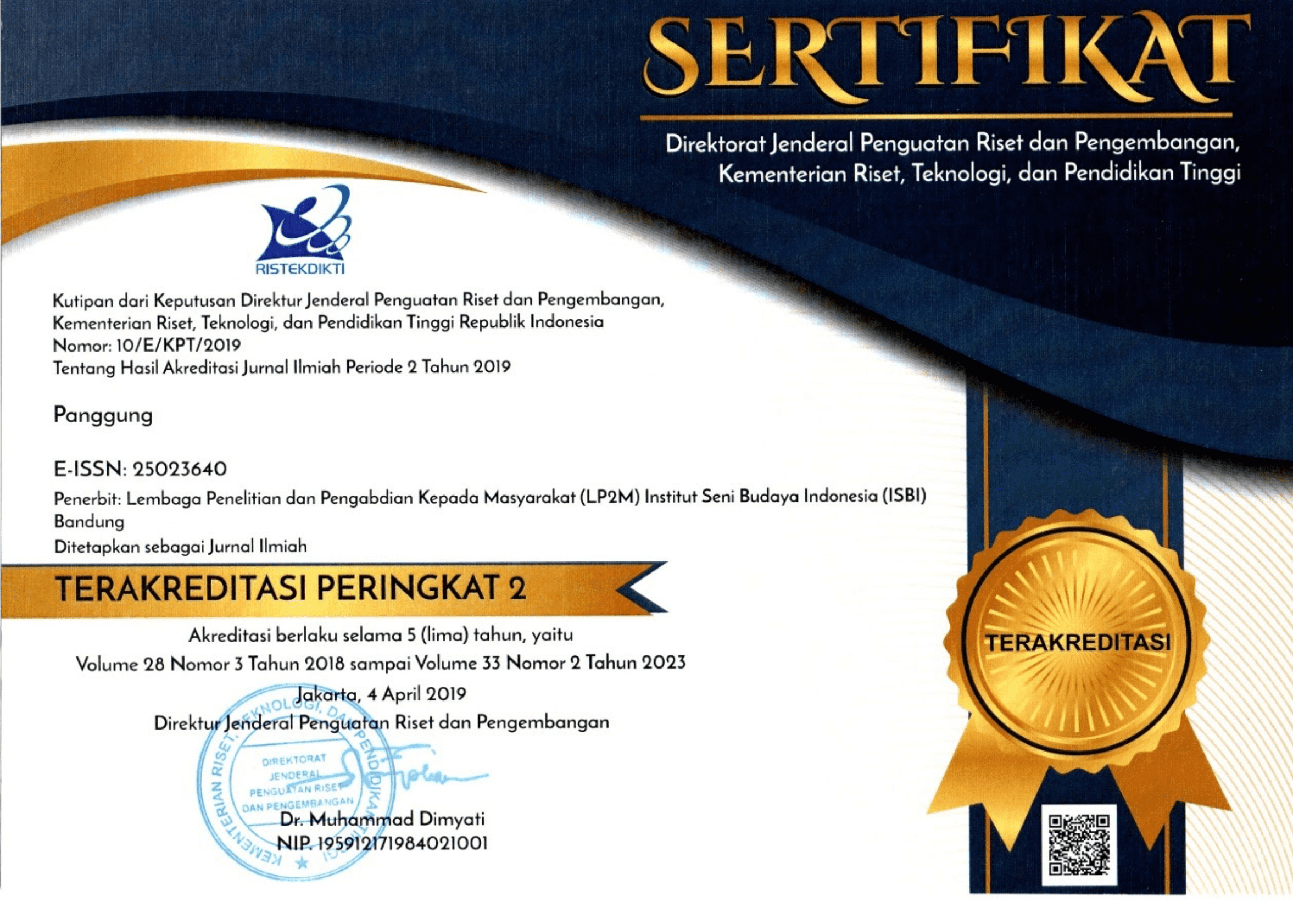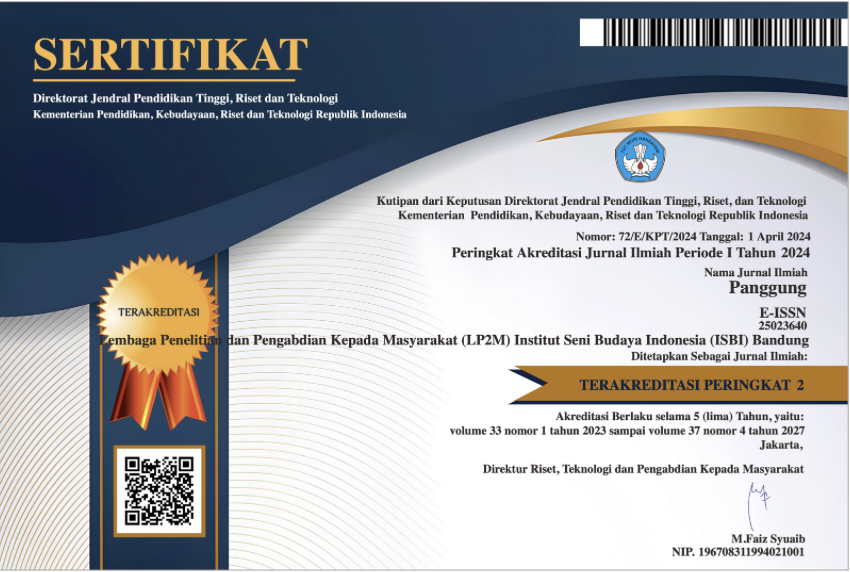Trajektori Hanami sebagai Diplomasi Budaya Jepang
DOI:
https://doi.org/10.26742/panggung.v32i4.2378Abstract
References
Baker, Joan Stanley. (1984). Seni Jepang, London : Thames dan Hudson
Chalcraft, J. (2021). Into the Contact Zones of Heritage Diplomacy: Local Realities, Transnational Themes and International Expectations. International Journal of Politics, Culture, and Society, 34(4), 487–501. https://doi.org/10.1007/s10767-020-09391-3
Chung, U., Mack, L., Yun, J. I., & Kim, S.-H. (2011). Predicting the Timing of Cherry Blossoms in Washington, DC nd Mid-Atlantic States in Response to Climate Change. PLoS ONE, 6(11), e27439. https://doi.org/10.1371/journal.pone.0027439
Cronin, P. (2013). How to do a Systematic Literature Review in Nursing. A Step-by-Step Guide. Nurse Education in Practice, 13(3), e9. https://doi.org/10.1016/j.nepr.2012.12.004
Endowment, Kate S. Buckingham (1977). Tosa Mitsuoki (Jepang, 1617-1691) : Ceri Berbunga dengan Slip Puisi, Chicago: Departemen Pendidikan Museum Institut Seni Chicago
Fenollosa, Ernest F.. (2007). Zaman Seni Cina dan Jepang : Garis Besar Sejarah Desain Asia Timur, Berkeley : Stone Bridge Press
Fukamachi, K., Oku, H., Kumagai, Y., & Shimomura, A. (2000). Changes in landscape planning and land management in Arashiyama National Forest in Kyoto. Landscape and Urban Planning, 52(2–3), 73–87. https://doi.org/10.1016/S0169-2046(00)00124-9
Flueckiger, Peter (2011) Membayangkan Harmoni : Puisi, Empati, dan Komunitas di Konfusianisme dan Nativisme Pertengahan Tokugawa, California: Stanford University Press
Gaudeková, H. (2013). Nuances of beautyYoshitoshi’s concept of women as a reflection of contemporary society. Annals of the Naprstek Museum, 34(1), 43–58.
Gavirati, P. M. (2020). Sakura, la Flor Japonesa en la Comunicación del Cambio Climático: Estudio Exploratorio sobre una Serie Periodística del Diario
Mainichi Shimbun (2016-2020). Historia Ambiental Latinoamericana y Caribeña (HALAC) Revista de La Solcha, 10(3), 25–54. https://doi.org/10.32991/2237-2717.2020v10i3.p25-54
Graham, Patricia J. (t.t.). Desain Jepang: Seni, Estetika & Budaya, Tokyo: Tuttle Publishing
Hwang, S.-H., & Chan, H.-Y. (2020). Cooperative Learning of SeiryuTai Hayashi Learners for the Hida Furukawa Festival in Japan. Sustainability, 12(10), 4292. https://doi.org/10.3390/su12104292
Lahdesmaki, T., & Ceginskas, V. L. A. (2022). Conceptualisation of heritage diplomacy in scholarship. International Journal of Heritage Studies, 28(5), 635–650. https://doi.org/10.1080/13527258.2022.2054846
Leipe, C., Kuramochi, S., Wagner, M., & Tarasov, P. E. (2020). Ritual practices and social organisation at the Middle Yayoi culture settlement site of Maenakanishi, eastern Japan. Archaeological andAnthropological Sciences, 12(7), 134. https://doi.org/10.1007/s12520-020-01098-y
Listiani, W., Ahimsa-Putra, H. S., LonoLastoroSimatupang, G., & Piliang, Y. A. P. A. (2013). RegenerativeRelational Tritangtu: Sundanese Triadic Transformation Model. Panggung, 23(2), 109–116. https://doi.org/10.26742/panggung.v23i2.91
Masago, Y., & Lian, M. (2022). Estimating the first flowering and full blossom dates of Yoshino cherry (Cerasus × yedoensis ‘Somei-yoshino’) in Japan using machine learning algorithms. Ecological Informatics, 71(January), 101835. https://doi.org/10.1016/j.ecoinf.2022.101835
Munsterberg, Hugo. (1982). Cetakan Jepang : Panduan Sejarah, Tokyo: John Weatherhil Inc
Nagai, S., Saitoh, T. M., & Yoshitake, S. (2019). Cultural ecosystem services provided by flowering of cherry trees under climate change: a case study of the relationship between the periods of flowering and festivals. International Journal of Biometeorology, 63(8), 1051–1058. https://doi.org/10.1007/s00484-019-01719-9
Noritake, Tsuda (2009). Sejarah Seni Jepang: Dari Prasejarah hingga Periode Taisho Tokyo : Tuttle Publishing
Ningsih, A. E. M., & Listiani, W. (2022). Taksonomi Intervensi Seni Kreatif untuk Kesehatan Mental. Panggung, 31(4), 454–466. https://doi.org/10.26742/panggung.v31i4.1787
Pandey, R. (2020). Rethinking the politics of gender and agency: an encounter with the ‘otherness’ of medieval Japan. Japan Forum, 32(4), 461–483. https://doi.org/10.1080/09555803.2018.1497676
Pantin, S. J., & Teelucksingh, J. (2017). Ideology, Regionalism, and Society in Caribbean History. In S. J. Pantin & J. Teelucksingh (Eds.), Ideology, Regionalism, and Society in Caribbean History. Springer International Publishing. https://doi.org/10.1007/978-3-319-61418-2
Robinson, J., & Carletti, L. (2019). Our Theatre Royal Nottingham: co-creation and co-curation of a digital performance collection with citizen scholars. International Journal of Performance Arts and Digital Media, 15(2), 128–148.https://doi.org/10.1080/14794713.2019.1633106
Rimer, J. Thomas (ed). (2012). Sejak Meiji : Perspektif Seni Visual Jepang, 1868-2000, Honolulu : Universitas Hawai’i Press
Sakurai, R., Jacobson, S. K., Kobori, H., Primack, R., Oka, K., Komatsu, N., & Machida, R. (2011). Culture and climate change: Japanese cherry blossom festivals and stakeholders’ knowledge and attitudes about global climate change. Biological Conservation, 144(1), 654–658. https://doi.org/10.1016/j.biocon.2010.09.028
Strange, Edward F. (t.t.). M.J.S., Ilustrasi Jepang: Sejarah Seni Memotong Kayu dan Pencetakan Warna di Jepang, London ;
George Bell dan Putra Tim Cross (2009). Ideologi Teh Jepang : Subjektivitas, Transains, dan Identitas Nasional, Kent : Global Oriental Ltd
Tuchman, Mitch (ed) (1986). Mahakarya dari Koleksi Shinenken : Lukisan Jepang Periode Edo, Los Angeles : Museum Seni Los Angeles County
Toyosawa, N. (2019). Introduction. Japan Forum, 31(4), 439–444. https://doi.org/10.1080/09555803.2019.1594343
Winter, T. (2015). Heritage diplomacy. International Journal of Heritage Studies, 21(10), 997–1015. https://doi.org/10.1080/13527258.2015.1041412
Ye, Hanyan (2015). A Symbol becomes the culture : Reinventing Japanese Cherry Blossoms, Centre for East and South-East Asian Studies, Lund Universit
Zubala, A., Kennell, N., & Hackett, S. (2021). Art Therapy in the Digital World: An Integrative Review of Current Practice and Future Directions. Frontiers in Psychology, 12(April). https://doi.org/10.3389/fpsyg.2021.600070
Downloads
Published
How to Cite
Issue
Section
Citation Check
License
Penulis yang menerbitkan jurnal ini menyetujui persyaratan berikut:
Penulis memiliki hak cipta dan memberikan jurnal hak publikasi pertama dengan karya yang secara simultan dilisensikan di bawah Creative Commons Attribution License yang memungkinkan orang lain untuk berbagi karya dengan pengakuan kepengarangan karya dan publikasi awal dalam jurnal ini.
Penulis dapat mengadakan perjanjian kontrak tambahan yang terpisah untuk distribusi non-eksklusif versi jurnal yang diterbitkan dari karya tersebut (misalnya, mempostingnya ke repositori institusional atau menerbitkannya dalam sebuah buku), dengan pengakuan atas publikasi awalnya dalam jurnal ini.
Penulis diizinkan dan didorong untuk memposting pekerjaan mereka secara online (mis., Dalam repositori institusional atau di situs web mereka) sebelum dan selama proses pengiriman, karena dapat menyebabkan pertukaran yang produktif, serta kutipan yang lebih awal dan lebih besar dari karya yang diterbitkan.
Authors who publish with this journal agree to the following terms:
Authors retain copyright and grant the journal right of first publication with the work simultaneously licensed under a Creative Commons Attribution License that allows others to share the work with an acknowledgement of the work's authorship and initial publication in this journal.
Authors are able to enter into separate, additional contractual arrangements for the non-exclusive distribution of the journal's published version of the work (e.g., post it to an institutional repository or publish it in a book), with an acknowledgement of its initial publication in this journal.
Authors are permitted and encouraged to post their work online (e.g., in institutional repositories or on their website) prior to and during the submission process, as it can lead to productive exchanges, as well as earlier and greater citation of published work.






